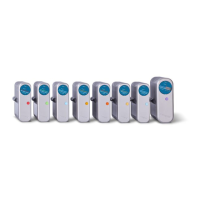ENGINEERING MANUAL OF AUTOMATIC CONTROL
CHILLER, BOILER, AND DISTRIBUTION SYSTEM CONTROL APPLICATIONS
361
Fig. 90. Effect of Flow Control on Finned
Tube Radiator Heat Output.
Supply Hot Water Temperature Control
With Flow Control
Combining flow control with supply water temperature reset
from outdoor air temperature or any other measurement of load
results in effective control.
Figure 93 shows output of a typical air heating coil with flow
and supply water temperature control. When 43°C water is
supplied during light load conditions, the maximum air
temperature rise through the coil is only 5 kelvins. With the
proper water temperature reset schedule, the control valve stays
in the 30 to 100 percent open range where flow control output
is linear. Thus, radical changes from desired output do not occur.
This is true for radiators, finned tubes, and reheat coils.
Fig. 91. Effect of Flow Control on Hot
Water Coil Heat Output.
Supply Hot Water Temperature Control
If supply water temperature is varied (reset) in response to a
change in heating load, heat output varies almost linearly
(Fig. 92). This mode of control appears ideal, except that it is
impractical to provide a different hot water temperature to each
heating coil or piece of radiation in a building. Varying supply
water temperature as a function of outdoor temperature
provides a good compromise.
Fig. 92. Supply Water Temperature vs
Heat Output at Constant Flow.
Fig. 93. Heat Output of Hot Water Coil
at Two Supply Temperatures.
Hot Water Reset
As previously discussed, reset of hot water supply
temperature is the most effective method of controlling heat
output of a water supplied heating coil, panel, radiator, or
convector. Heat output of most water supplied heating is
relatively linear with respect to supply water temperature. Water
temperature reset can be provided by a steam to hot water
converter, a three-way valve, or boiler water temperature reset.
Reset of hot water using a steam to hot water converter is
discussed in this section.
HOT WATER CONVERTER
The supply water temperature to the radiant panel (Fig. 94) is
reset by the controller modulating a valve in the converter steam
supply. The controller uses the temperatures at the outdoor air
sensor and the supply water sensor to control the steam supply
valve. The valve is positioned to maintain the converter discharge
water temperature as determined by the reset schedule and outdoor
air temperature. A typical reset schedule is shown in Table 5.
75% FLOW REDUCTION
FLOW, L/s
HEAT OUTPUT %
100
75
50
25
0
0.6 1.2 1.8 2.4 3.0
RATED OUTPUT
C4609
65
60
55
50
45
40
35
30
25
20
15
10
5
0
15.0
13.5
12.0
10.5
9.0
7.5
6.0
4.5
3.0
0
0 102030405060708090100
PERFORMANCE CURVE FOR HOT WATER COIL
95°C ENTERING WATER
27°C ENTERING AIR
HEAT
OUTPUT
TEMP
DROP OF
WATER
TEMP DROP OF WATER (KELVINS)
KILOWATTS
PERCENT FLOW
C4610
HOT WATER
UNIT HEATER
RADIANT
PANEL
CONVECTORS
AND
RADIATORS
100
90
80
70
60
50
40
30
20
10
0
25 35 65 85
SUPPLY WATER TEMPERATURE °C
HEAT OUTPUT, PERCENT
C4611
100
90
80
70
60
50
40
30
20
10
0
0 0.5 0.10 0.15 0.20 0.25 0.30 0.35 0.40 0.45
18
15
12
9
6
3
0
LINEAR RANGE
OUTPUT
45°C SUPPLY
WATER
OUTPUT
95°C WATER
FLOW-L/s
% OF RATED HEAT OUTPUT
AIR TEMP RISE THRU COIL (KELVINS)
C4612

